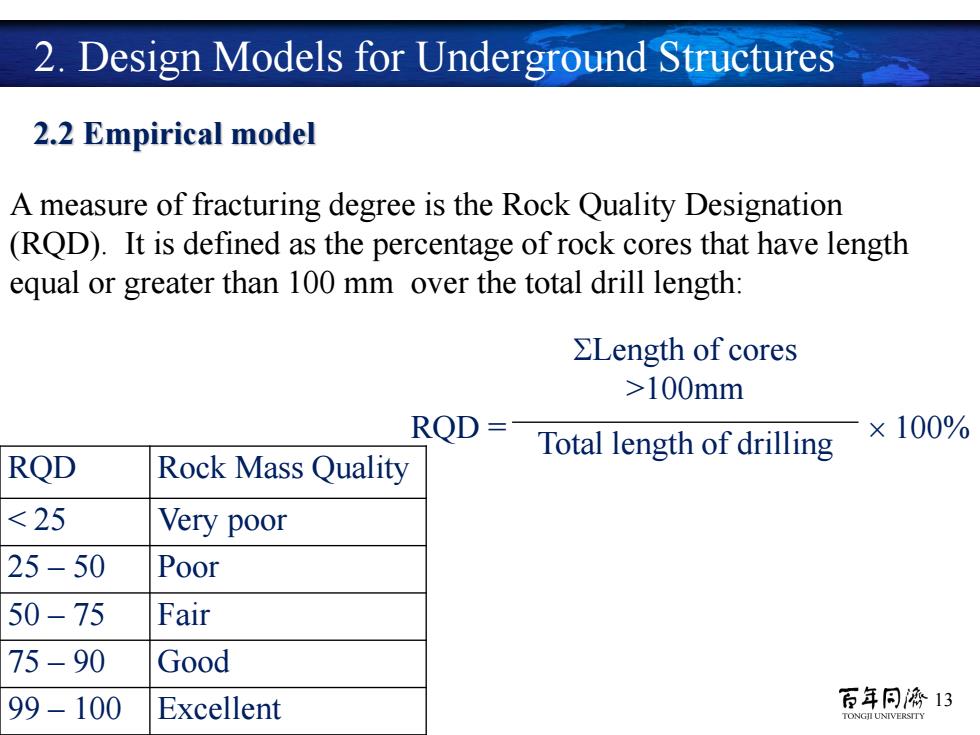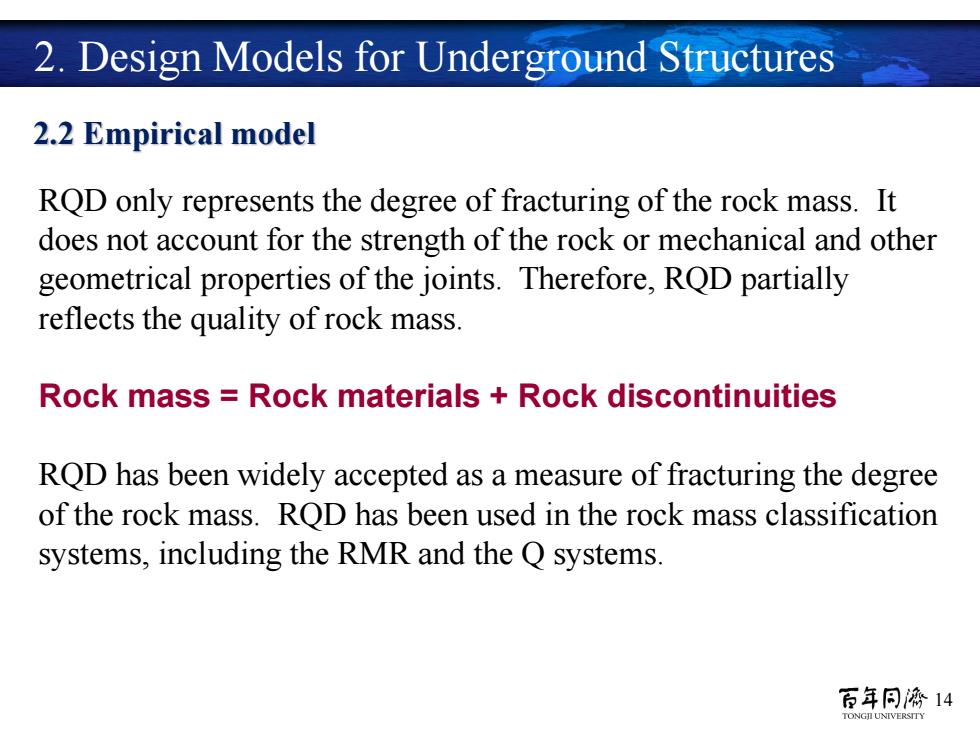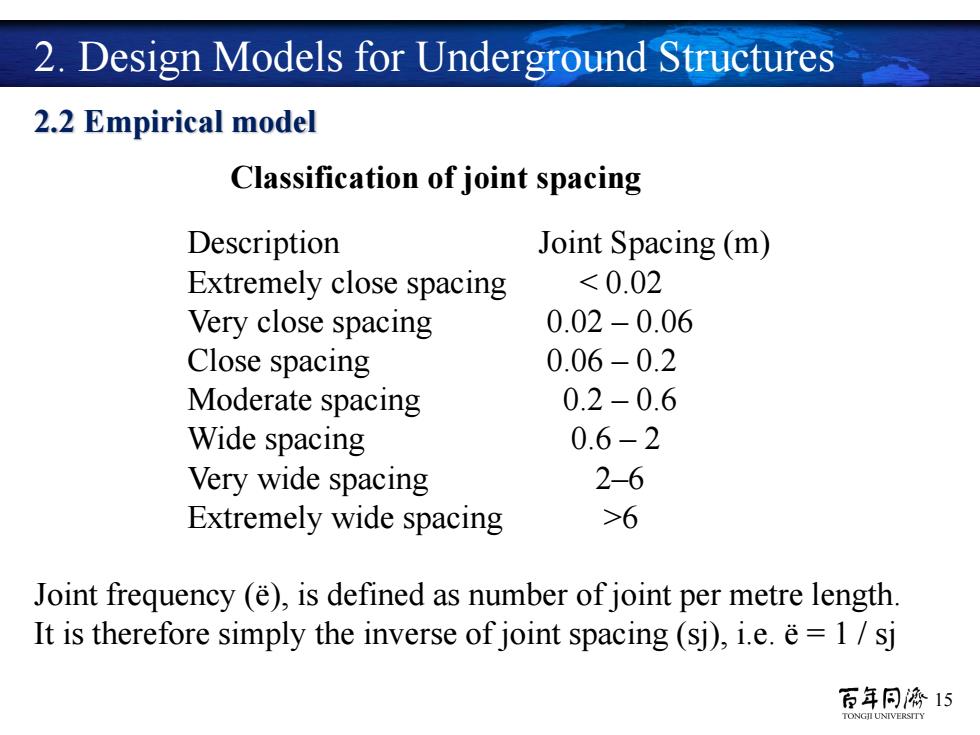
2.Design Models for Underground Structures 2.2 Empirical model Rock UC Strength(MPa) Tensile Strength (MPa) Granite 100-300 7-25 Dolerite 100-350 7-30 Gabbro 150-250 7-30 Basalt 100-350 10-30 Sandstone 20-170 4-25 Shale 5-100 2-10 Dolomite 20-120 6-15 Limestone 30-250 6-25 Gneiss 100-250 7-20 Slate 50-180 7-20 Marble 50-200 7-20 Quartzite 150-300 5-20 百年同濟12 TONGILUNIVERSITY
12 Rock Granite Dolerite Gabbro Basalt Sandstone Shale Dolomite Limestone Gneiss Slate Marble Quartzite UC Strength (MPa) 100 – 300 100 – 350 150 – 250 100 – 350 20 – 170 5 – 100 20 – 120 30 – 250 100 – 250 50 – 180 50 – 200 150 – 300 Tensile Strength (MPa) 7 – 25 7 – 30 7 – 30 10 – 30 4 – 25 2 – 10 6 – 15 6 – 25 7 – 20 7 – 20 7 – 20 5 – 20 2.2 Empirical model 2. Design Models for Underground Structures

2.Design Models for Underground Structures 2.2 Empirical model A measure of fracturing degree is the Rock Quality Designation (RQD).It is defined as the percentage of rock cores that have length equal or greater than 100 mm over the total drill length: ELength of cores >100mm ×100% RQD Rock Mass Quality RQD=Total length of drilling <25 Very poor 25-50 Poor 50-75 Fair 75-90 Good 99-100 Excellent 百年同濟13
13 2.2 Empirical model 2. Design Models for Underground Structures RQD = Length of cores >100mm 100% Total length of drilling A measure of fracturing degree is the Rock Quality Designation (RQD). It is defined as the percentage of rock cores that have length equal or greater than 100 mm over the total drill length: RQD Rock Mass Quality < 25 Very poor 25 – 50 Poor 50 – 75 Fair 75 – 90 Good 99 – 100 Excellent

2.Design Models for Underground Structures 2.2 Empirical model ROD only represents the degree of fracturing of the rock mass.It does not account for the strength of the rock or mechanical and other geometrical properties of the joints.Therefore,RQD partially reflects the quality of rock mass. Rock mass Rock materials Rock discontinuities ROD has been widely accepted as a measure of fracturing the degree of the rock mass.ROD has been used in the rock mass classification systems,including the RMR and the Q systems. 百年同濟14 TONGILUNIVERSITY
14 RQD only represents the degree of fracturing of the rock mass. It does not account for the strength of the rock or mechanical and other geometrical properties of the joints. Therefore, RQD partially reflects the quality of rock mass. Rock mass = Rock materials + Rock discontinuities RQD has been widely accepted as a measure of fracturing the degree of the rock mass. RQD has been used in the rock mass classification systems, including the RMR and the Q systems. 2.2 Empirical model 2. Design Models for Underground Structures

2.Design Models for Underground Structures 2.2 Empirical model Classification of joint spacing Description Joint Spacing (m) Extremely close spacing <0.02 Very close spacing 0.02-0.06 Close spacing 0.06-0.2 Moderate spacing 0.2-0.6 Wide spacing 0.6-2 Very wide spacing 2-6 Extremely wide spacing >6 Joint frequency (e),is defined as number of joint per metre length It is therefore simply the inverse of joint spacing(sj),i.e.e=1/sj 百年同濟15
15 Description Joint Spacing (m) Extremely close spacing < 0.02 Very close spacing 0.02 – 0.06 Close spacing 0.06 – 0.2 Moderate spacing 0.2 – 0.6 Wide spacing 0.6 – 2 Very wide spacing 2–6 Extremely wide spacing >6 Classification of joint spacing Joint frequency (ë), is defined as number of joint per metre length. It is therefore simply the inverse of joint spacing (sj), i.e. ë = 1 / sj 2.2 Empirical model 2. Design Models for Underground Structures

2.Design Models for Underground Structures 2.2 Empirical model Designation Volumetric Joint Count,joints/m3 Very large blocks <1 Large blocks 1-3 Medium-sized blocks 3-10 Small blocks 10-30 Very small blocks >30 Crushed rock >60 百年同海16 TONGILUNIVERSITY
16 Volumetric Joint Count, joints/m3 <1 1–3 3 – 10 10 – 30 > 30 > 60 Designation Very large blocks Large blocks Medium-sized blocks Small blocks Very small blocks Crushed rock 2.2 Empirical model 2. Design Models for Underground Structures